Commercial warehouse lighting plays a vital role in the success of any industrial operation. It affects worker safety, productivity, and energy efficiency, making it a critical aspect of warehouse management.
At PacLights, we understand the complexities of designing an effective lighting system for large-scale facilities. This blog post will guide you through the key factors to consider when optimizing your warehouse lighting setup.
Why Proper Warehouse Lighting Matters
Safety First: Illuminating Hazards
In warehouses where forklifts move rapidly and workers handle heavy loads, visibility is paramount. Poor lighting increases the risk of accidents, injuries, and costly downtime. The U.S. Occupational Safety and Health Administration (OSHA) uses foot candles as a measurement for workplace lighting, requiring at least one lumen of light per square foot of space. High-quality LED fixtures significantly reduce shadows and dark spots, making potential hazards more visible and easier to avoid.
Boosting Productivity Through Better Visibility
Well-designed lighting doesn’t just prevent accidents; it actively enhances worker performance. A study by the Light Right Consortium found that improved lighting can increase productivity by up to 8%. This boost results from reduced eye strain, better color rendering for accurate product identification, and an overall more comfortable work environment. High bay and linear strip lights provide uniform, glare-free illumination that supports these productivity gains.
The Bottom Line: Energy Efficiency and Cost Savings
Switching to energy-efficient lighting is a smart financial move. The U.S. Department of Energy estimates that LED lighting can reduce energy consumption by up to 75% compared to traditional lighting systems. This translates to substantial savings on electricity bills. Moreover, the long lifespan of LED fixtures (often 50,000 hours or more) means fewer replacements and lower maintenance costs. LED solutions, coupled with optional daylight and motion controls, can maximize these savings even further.
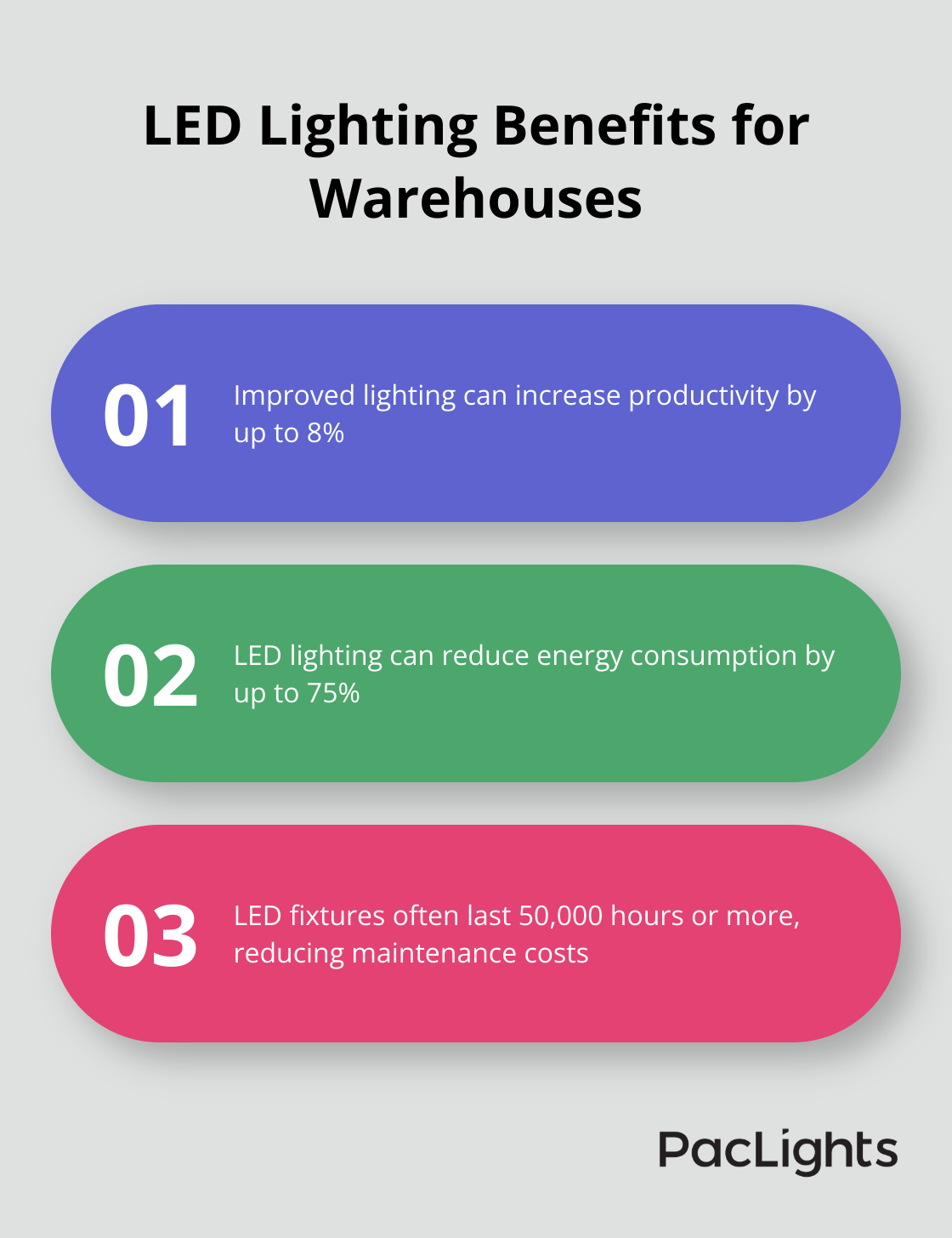
Meeting and Exceeding Regulatory Standards
Compliance with lighting regulations is non-negotiable in the warehouse industry. Standards set by organizations like the Illuminating Engineering Society (IES) and OSHA dictate minimum light levels for different areas and tasks within a warehouse. Modern LED systems not only meet these standards but often exceed them, providing better illumination with less energy. Many LED fixtures are designed with these regulations in mind, ensuring that your warehouse not only complies but operates at peak efficiency.
Adapting to Changing Needs
Warehouse operations are dynamic, with changing inventory layouts and evolving work processes. A flexible lighting system adapts to these changes without requiring extensive modifications. LED lighting systems offer this flexibility through adjustable fixtures, modular designs, and smart controls. This adaptability ensures that your lighting remains optimal even as your warehouse operations evolve.
As we move forward, it’s essential to understand the key factors that contribute to effective warehouse lighting design. These elements will help you create a lighting plan that maximizes safety, productivity, and energy efficiency in your facility.
Designing Effective Warehouse Lighting
Uniform Light Distribution
Effective warehouse lighting starts with uniform distribution. Uneven lighting creates dark spots and shadows, which increase accident risks and hinder task performance. The layout of your warehouse, including shelf heights and machinery placement, influences light distribution.
High bay LED fixtures excel in warehouses with high ceilings. A 200W LED high bay light can illuminate up to 3,000 square feet when installed at a 30-foot height. Strategic placement of these fixtures creates consistent light levels across your facility.
Color Rendering and Temperature
Color quality impacts worker performance and product identification. The Color Rendering Index (CRI) measures how accurately a light source reveals true colors compared to natural daylight. Warehouse applications benefit from a CRI of 80 for general use, while environments requiring more accurate color perception may need a CRI of 90-95.
Color temperature (measured in Kelvin) affects ambiance and alertness. Cooler temperatures (5000K-6500K) promote alertness in task-oriented areas. Warmer temperatures (2700K-3500K) suit break rooms or office spaces within the warehouse.
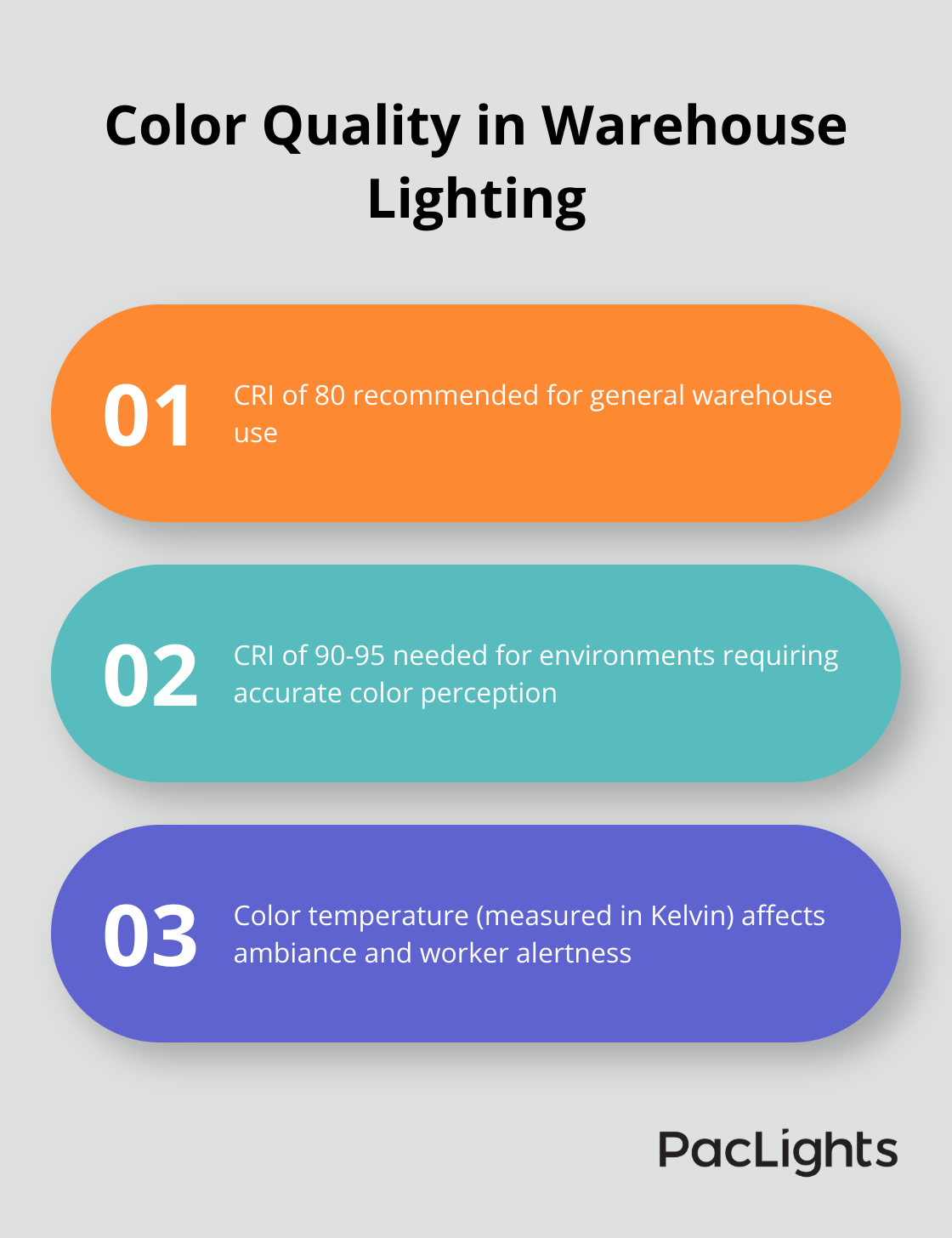
Glare and Shadow Reduction
Glare causes eye strain, headaches, and reduced visibility, which decrease productivity and increase accident risk. Fixtures with diffusers or lenses spread light evenly and reduce direct glare. Optimal positioning of lights also minimizes glare issues.
Shadow elimination matters, especially in areas with high shelving or large equipment. Linear LED strip lights mounted vertically along shelving units illuminate aisles effectively and reduce shadows from stored items.
Task-Specific Lighting
Different warehouse areas require varying illumination levels. The Illuminating Engineering Society (IES) recommends specific light levels for different tasks:
- General warehouse areas: 10-20 foot-candles
- Picking and packing areas: 20-50 foot-candles
- Shipping and receiving docks: 30-50 foot-candles
- Office spaces: 50-75 foot-candles
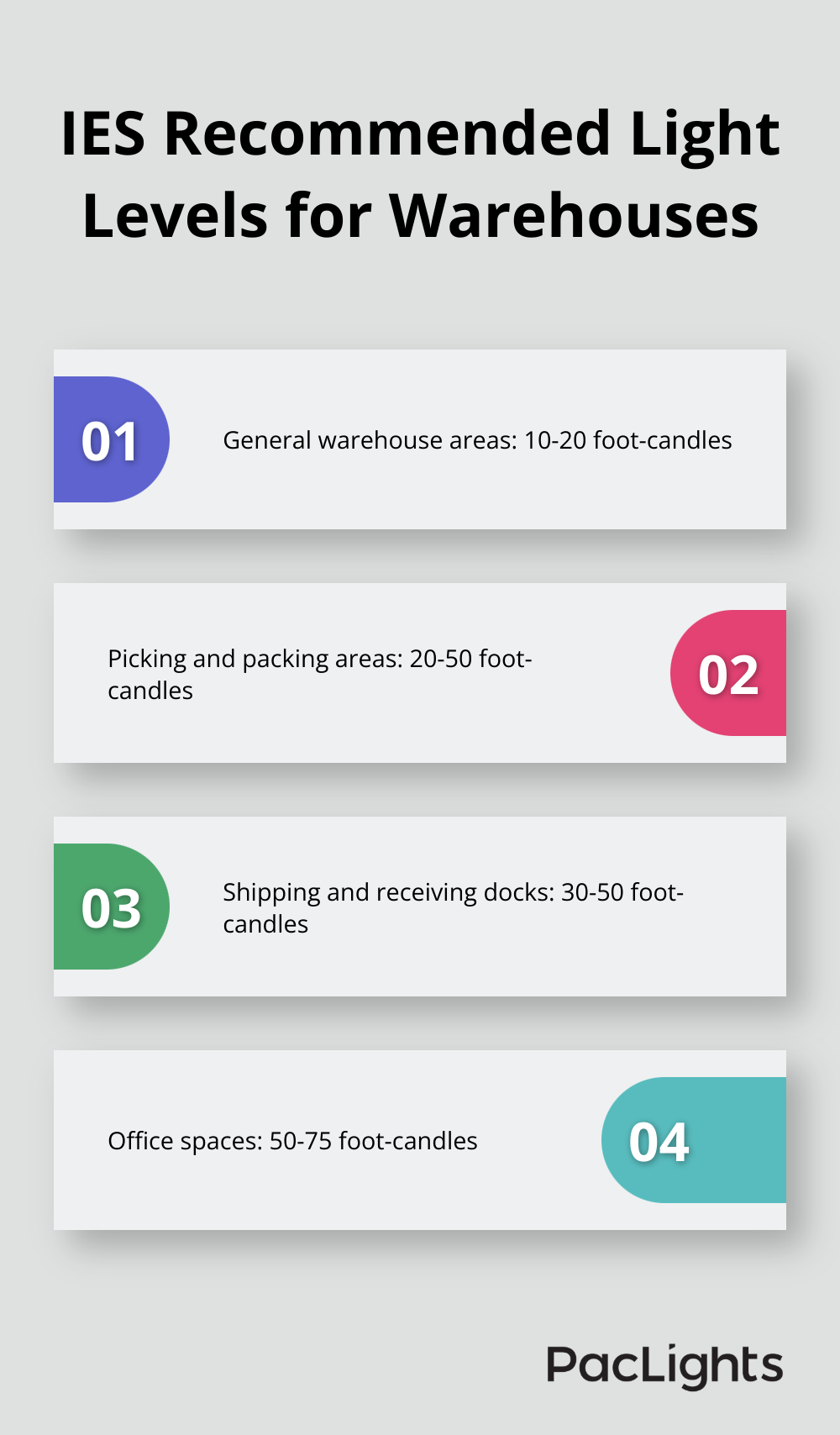
A flexible lighting system adapts to these different needs. Dimmable LED fixtures and smart lighting controls (such as those offered by PacLights) allow light level adjustments based on tasks, time of day, or occupancy. This optimization enhances energy use and worker comfort.
Future-Proofing Your Lighting Design
Warehouse operations evolve over time. Your lighting system should accommodate changes in layout, inventory, and processes. Modular LED systems offer flexibility for future modifications without extensive rewiring or fixture replacement.
Smart lighting controls future-proof your investment by allowing remote management and data collection. These systems can integrate with other building management tools, providing valuable insights into energy use and occupancy patterns.
The next step in optimizing your warehouse lighting involves selecting the right solutions to implement your design effectively. Let’s explore the various lighting options available for different areas of your facility.
Selecting Optimal Warehouse Lighting Solutions
High Bay LEDs: The Warehouse Workhorse
For general illumination in warehouses with high ceilings, LED high bay lights stand out as the top choice. These powerful fixtures provide broad, uniform light coverage essential for large open spaces. One of the main differences between metal halide lights and energy efficient high bay lights is the output. Metal halides offer a reliable output, but LED high bays can provide significant energy savings.
High bay LEDs also offer impressive energy savings. Compared to traditional metal halide fixtures, LEDs can reduce energy consumption significantly. This translates to significant cost savings over time.
Task-Specific Lighting for Precision Work
While high bays handle general illumination, task-specific lighting proves essential for areas that require more focused light. In picking and packing zones, linear LED strip lights mounted under shelving units can provide the extra illumination needed for accurate order fulfillment. These strips are easy to install, energy-efficient, and can link together for custom configurations.
For inspection areas or workstations, adjustable LED task lights give workers control over their immediate lighting environment. This personalized approach not only improves visibility but can also boost productivity.
Smart Controls for Maximum Efficiency
The incorporation of smart lighting controls can take warehouse lighting to the next level of efficiency. Motion sensors ensure lights turn on only when needed, potentially reducing energy use in less frequently occupied areas. Daylight harvesting systems automatically adjust artificial light levels based on available natural light, further optimizing energy use.
These smart systems not only save energy but also provide valuable data. Through tracking occupancy patterns and energy usage, you can gain insights to refine your warehouse operations. Some advanced systems even integrate with inventory management software, using light-based indoor positioning to streamline picking processes.
Customized Solutions for Specific Needs
Every warehouse has unique lighting requirements based on its layout, operations, and specific tasks. A combination of different lighting solutions often yields the best results. For example, you might use high bay LEDs for general illumination, task lighting in workstations, and smart controls throughout the facility.
Try to consider factors such as color temperature and color rendering index (CRI) when selecting your lights. Cooler temperatures promote alertness in task-oriented areas, while warmer temperatures suit break rooms or office spaces. A high CRI ensures accurate color perception, which is important for product identification and quality control.
Future-Proofing Your Lighting Investment
When selecting lighting solutions, consider their adaptability to future changes in your warehouse operations. Modular LED systems offer flexibility for future modifications without extensive rewiring or fixture replacement. Smart lighting controls allow for remote management and data collection, integrating with other building management tools to provide valuable insights into energy use and occupancy patterns.
Final Thoughts
Commercial warehouse lighting optimization improves safety, productivity, and energy efficiency. LED technology, smart controls, and task-specific solutions offer unmatched flexibility and efficiency in warehouse illumination. Professional lighting design ensures that your system meets current needs and adapts to future operational changes.
PacLights specializes in cutting-edge lighting solutions for commercial and industrial facilities. Our product range includes high bay LEDs, linear strip lights, and smart control systems designed to optimize warehouse lighting. We offer free lighting layout designs and ROI assessments to help you make informed decisions about your lighting investment.
Optimized warehouse lighting creates a safer, more productive, and efficient work environment. As technology advances, innovative lighting solutions for warehouses will continue to grow (offering even more opportunities for improvement). Invest in a lighting system that enhances your operations while reducing your carbon footprint and energy costs.


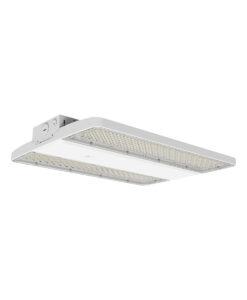
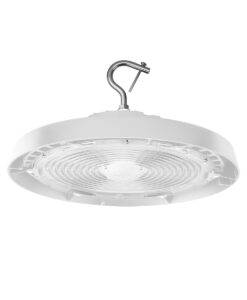
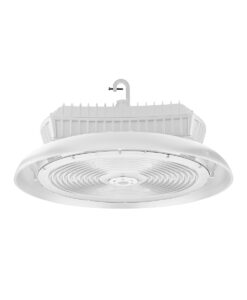
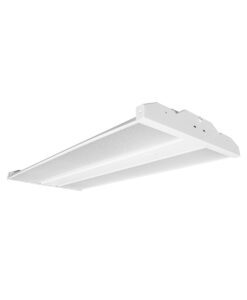
Disclaimer: PacLights is not responsible for any actions taken based on the suggestions and information provided in this article, and readers should consult local building and electrical codes for proper guidance.